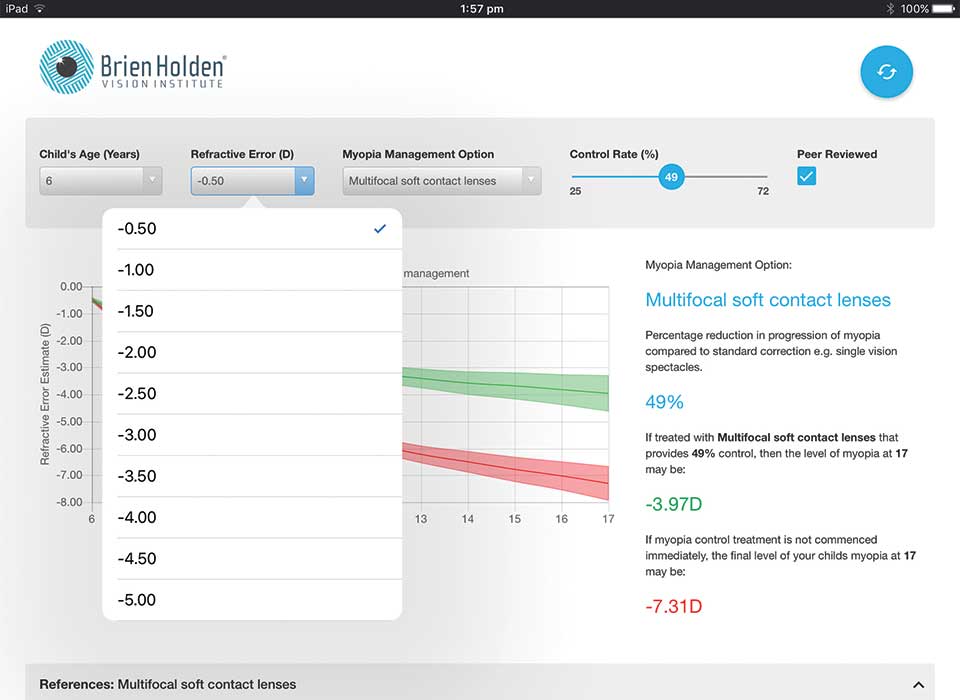- OT
- Professional support
- Optical organisations
- Calculating myopia
Key milestones
Calculating myopia
Science and technology manager at the Brien Holden Vision Institute, Fabian Conrad, discusses the establishment of its free-to-use myopia calculator

16 January 2018
01 We began to develop the myopia calculator in January 2016 when we looked at the vast amount of data that we were producing at the Brien Holden Vision Institute (BHVI) around myopia and its management.
Through the calculator, we wanted to be able to make sense of that data and offer it to clinicians in a useable way.
Available as an online tool, the calculator enables eye care practitioners to apply the research-based evidence that is being produced globally and support them when communicating to and educating patients about myopia and its management options.
To use the calculator, the practitioner inputs a patient’s age and refractive error.
The tool then shows the various management options and scenarios available, and demonstrates the possible benefits, over time, of starting to treat myopia progression.
The calculator does not preference any particular management option, such as soft contact lenses or ortho-k. It is a completely neutral tool to support practitioners and patients in understanding a product and then using it.
02 The myopia calculator has been accessed 15,000 times since its launch on 21 August 2017. I don’t think the BHVI has ever had anything else on its website that has received so much positive feedback.
It has had a good reception from everyone from industry heads and decision makers in large and small contact lens companies, to academics and practitioners using the tool themselves.
It is currently free to access via our website and there are certainly no plans to monetise it. We are in a unique position at the BHVI; we are a leader in the field of myopia and carry out at lot of research into it. We have the skills to produce and analyse this data and feel that we have an ethical obligation to make that data available to optometrists in practice in a useable manner so that they can share it with the public and take action.
Myopia is not something that is easy to explain to patients. Therefore, the calculator has been built to be easily understandable specifically in order to help practitioners demonstrate the risk versus the potential benefit of treatment to parents.
"The myopia calculator has been accessed 15,000 times since its launch on 21 August"
03 The calculator is only as good as the data that is entered into the system to use. We are therefore looking to continually update the tool as more studies are peer reviewed and published, and the data becomes available.
The calculator has been described as a digester of scientific literature because the literature featured is relatively wide. It does not just contain data that has been produced by the BHVI, but a wide range of data from researchers around that world – anything that is peer reviewed that we could get our hands on. If the data is valid, we will edit it and use it on the calculator.
As relevant data is published, we will look to update the calculator with it. This is important as it ensures practitioners have a constantly valid tool to use.

04 Myopia is a big public health problem and will continue to be in the future as its prevalence grows.
Yet myopia management presents the optometrist with a unique opportunity to actually change someone’s visual outcome; to slow something down and change a diagnosis. The calculator helps them embrace this opportunity.
It is a support tool; it helps practitioners to understand what they are doing in terms of myopia management and helps them explain to parents why it is the most suitable option.
Practitioners have a duty to ensure patients are aware of and understand myopia. When parents understand myopia and its treatment better, there will be a natural increase in management uptake.
05 In the future, it would be nice if the calculator became the gold standard and that it was accepted by everyone in the profession globally.
We would also like to get to the point where people are submitting their research findings for inclusion and letting us know when there is data worth adding.
The tool is currently website-based and works well on desktop, tablet and smartphone. Since the launch, there has been talk of creating an app for the calculator, which is certainly something that we will explore if the demand is there. From a programming point of view, the website has already been built to be responsive so I don’t think it would require a lot of work to turn it into an app.
Image credit: Flickr
Advertisement


Comments (0)
You must be logged in to join the discussion. Log in